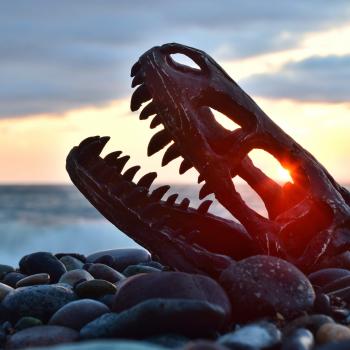With Halloween approaching, Christians find ourselves re-litigating the arguments for and against participating in this odd holiday. I’m forever indebted to Steven Wedgeworth, whose essay on the day’s true origins at The Calvinist International puts to rest a great deal of foolishness evangelicals have taught about Halloween over the years.
But I can’t help wondering: what now? Divested of its apocryphal Pagan origins, and placed alongside its likely Christian inspiration, All Saints Day (November 1st), Halloween isn’t the beast our fundamentalist Sunday school teachers described. And yet. Viewed through a clearer historical lens, the whole thing might look harmless, if it weren’t for the way it—well—looks.
Think about it: Even this holiday’s more cartoonish expressions involve skeletons, ghosts, goblins aplenty and constant reminders of death. Preposterous-looking witches stalk lawns and toothy pumpkins leer at passersby from porches. There’s even an occasional teenager dressed as the Devil. Surely all of this aesthetic smoke must point to a spiritual fire. This night just seems like a celebration of evil, even if it lacks any real occult pedigree.
Or so I often hear.
Beneath this very common line of reasoning is an untroubled assumption that whatever is “good,” “pure,” “true,” “lovely,” and “praiseworthy” will look like my grandmother’s Precious Moments collection. But I don’t find this equation of the macabre with evil convincing, at least not in the way so many Christians I’ve talked with do.
Set aside the fact that the last few chapters of Judges are as much God-breathed Scripture as the Sermon on the Mount—rape, dismemberment, Fed-Exing of body parts and all. Experience suggests that the fearful, the deathly, and yes, even the spooky are as much of a piece with the human condition as the beautiful and jubilant. Those who deny this only to live in fear of children in masks knocking on their doors and asking for Jolly Ranchers are walking ironies.
But I have a better reason for being okay with much of the Halloween aesthetic. It’s no accident that our celebration of the spooky, whatever its origins, happens in the autumn. This is the time when the most evident signs of life all around us wither and fall to the earth. Naked branches clutch like hands, often silhouetted against the night sky. For those in temperate climates, nature takes an inhospitable turn. In much of the United States, the sky becomes obscured with near-perpetual gloom. During the right weather front, creation can audibly groan. These seasonal foreshadowings of our own impending deaths are impossible to ignore. Indeed, people have noticed them for millennia.
Noticed them, and enjoyed them.
Paradoxically, nature’s reminders of mortality, much like the thrills of a haunted house or a horror film, can make us feel alive. So can the thought of what inhabits this perilous world. The instinctive fear of something out there, real or imagined—something that means you harm—is exciting. If you’ve ever felt the sea floor drop out from under your feet and shuddered at what might lurk beneath—if your neck has ever prickled while you walked through a forest at night—if you’ve ever fought the urge to look over your shoulder while climbing the stairs out of a dark basement—you know the odd mix of dread and delight that I’m talking about.
This quickening of the pulse isn’t bad. Nor is it merely chemical—the flickering of atrophied adrenal glands in a prey species that has evolved beyond the reach of predators. The danger, the carnivory, nature’s red teeth and claws, the fear of the unknown, and the sight of a human skull (even a plastic one)—these are pictures of the enmity that still exists between us and our inheritance, and between our Father and His world. They are reminders of the work that remains to be done, of the enemies that remain to be defeated, of the bad things that have yet to come untrue.
Far from dispensable, I suspect that the spooky, macabre, and generally Halloween-ish serves as an essential plot element in the story of redemption—as a cue that the drama in which we are actors hasn’t yet reached its resolution. Even more, these things are a call for us to throw ourselves into that drama, and to win a glory here in time that will never fade in eternity.
Really, this isn’t so strange. When we read a novel, we don’t skip over the antagonist or his dark deeds. When we listen to a symphony, we don’t shut out the notes played in a minor key. When we walk through a cemetery, we don’t ignore the dry bones that lie buried. Otherwise, where will the glory be when they live again? And when we retell how the brave knight slew the dragon, we know that the more sinister our description of the dragon, the greater the triumph of the knight. Even children know that you don’t tell satisfying stories by skimping on the claws and teeth and dark, stormy nights.
This concept of fear as life-giving reminds me of a scene from C. S. Lewis’ “Out of the Silent Planet,” the first book in his Cosmic Trilogy. His protagonist joins a tribe of Martian natives called Hrossa on their hunt for a mythic sea-beast called the Hnakra. Many Hrossa have died in the hunt for this leviathan, but the fear and peril are for them a crucial rite of passage. More than that, the retelling of that fear and peril for those who’ve overcome the beast are sources of undying glory. Lewis’ protagonist thinks this strange at first. But soon he is caught up in the thrill of the chase, reveling in the existence of the monster and even feeling a kind of sorrow at its demise.
As someone who finds that same counter-intuitive vitality in fear, I get where Lewis was coming from.
There’s no historical case to be made that Halloween is tied to Paganism or devil-worship. If anything, its ghoulish aesthetic began as folk-mockery of Satan and his kingdom. Certainly, it’s possible to abuse the aesthetic, to fail to love your neighbor, or to be downright tacky (I’m looking at you, guy with the Chainsaw-Massacre yard). There are probably even some wannabe-witches out there who feel the holiday was made-to-order for them (although I’ve run across just as many who say the opposite).
But to me, Halloween and its spooky aesthetic are ripe for the telling of a fairy-story about a world gripped by the wages of sin—a world where there is still real danger, where monsters still lurk in the shadows, and where heroic deeds remain to be done. And as any good author can tell you, skimping on the monsters and the danger is no way to tell a satisfying story.












